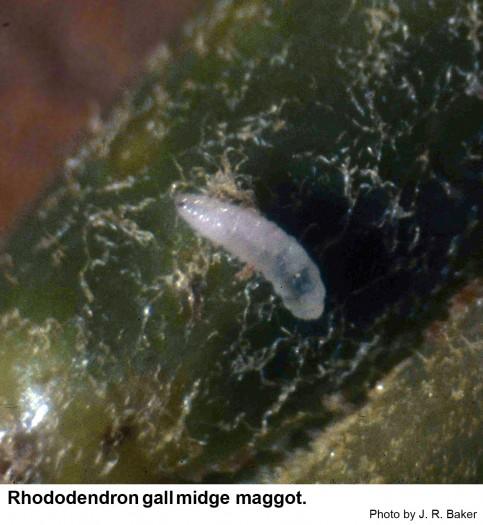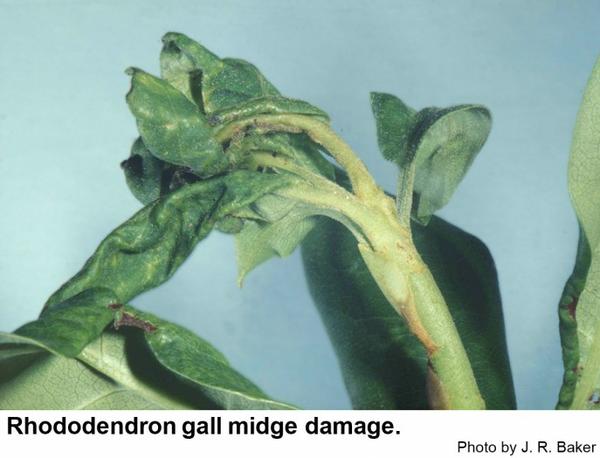Description and Biology
The rhododendron gall midge, Clinodiplosis rhododendri, seems to attack only the new growth of rhododendrons. This gall midge is light brown and very small mosquito-like fly. Males are hairy and have antennae longer than the body. Females have a short ovipositor and antennae about as long as its body. The flattened maggot is whitish and visible but very small. These pests overwinter as prepupae (a non feeding maggot stage) inside a flimsy, silk cocoon in the soil. In spring, the maggots pupate and the adult flies emerge a short time later to lay eggs as new plant growth develops. Newly hatched larvae feed within the puckered and curled leaf margins. If many larvae are found in a bud, the bud may die completely. If the buds are infested later, the new leaves curl in on the margins, and the tiny white maggots develop inside the tightly rolled plant tissue. About a week later, the maggots drop to the soil to spin their cocoons and pupate. Damage first appears in late May or early June and often reappears later with each flush of growth during the growing season. We may have three or more generations per year here in North Carolina. Heavy infestations of this pest are unusual and sporadic, but when they do occur, the gall midges can cause extensive damage.
Host Plants
Both Rhododendron catawbiensis and R. maximum are susceptible to the rhododendron gall midge. Infested buds produce puckered, discolored leaves that may drop prematurely.
Residential Recommendation
An effective cultural control method for homeowners is the removal and destruction of newly infested foliage. This practice may eliminate the problem within a single year or two. No chemicals are currently registered for control of rhododendron gall midges. Try Orthene or imidacloprid as a thorough spray as the new growth emerges to try to control the maggots before extensive damage is done.
References
- Insect and Related Pests of Shrubs. Baker, J. R. ed. 1980. NC Agricultural Extension Service publication AG-189. 199 pp.
- Rhododendron Gall Midge. Abbey, T. 2004. Univ. Connecticut, College Agr. and Nat. Resources Fact Sheet.
- Rhododendron Insect Pests. Anonymous. 2016 (revised). UConn Home and Garden Education Center U-4115.
- Extension Plant Pathology Publications and Factsheets
- Horticultural Science Publications
- North Carolina Agricultural Chemicals Manual
For assistance with a specific problem, contact your local N.C. Cooperative Extension Center.
This Factsheet has not been peer reviewed.
Publication date: Nov. 11, 2013
Revised: Oct. 11, 2019
Recommendations for the use of agricultural chemicals are included in this publication as a convenience to the reader. The use of brand names and any mention or listing of commercial products or services in this publication does not imply endorsement by NC State University or N.C. A&T State University nor discrimination against similar products or services not mentioned. Individuals who use agricultural chemicals are responsible for ensuring that the intended use complies with current regulations and conforms to the product label. Be sure to obtain current information about usage regulations and examine a current product label before applying any chemical. For assistance, contact your local N.C. Cooperative Extension county center.
N.C. Cooperative Extension prohibits discrimination and harassment regardless of age, color, disability, family and marital status, gender identity, national origin, political beliefs, race, religion, sex (including pregnancy), sexual orientation and veteran status.


